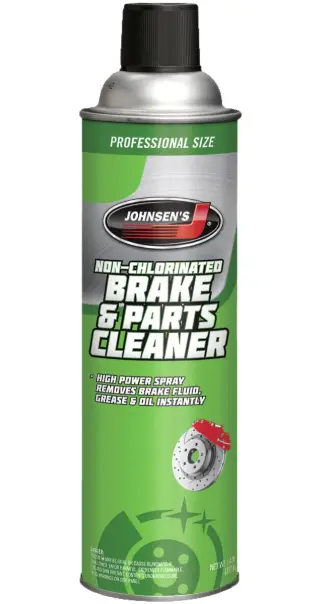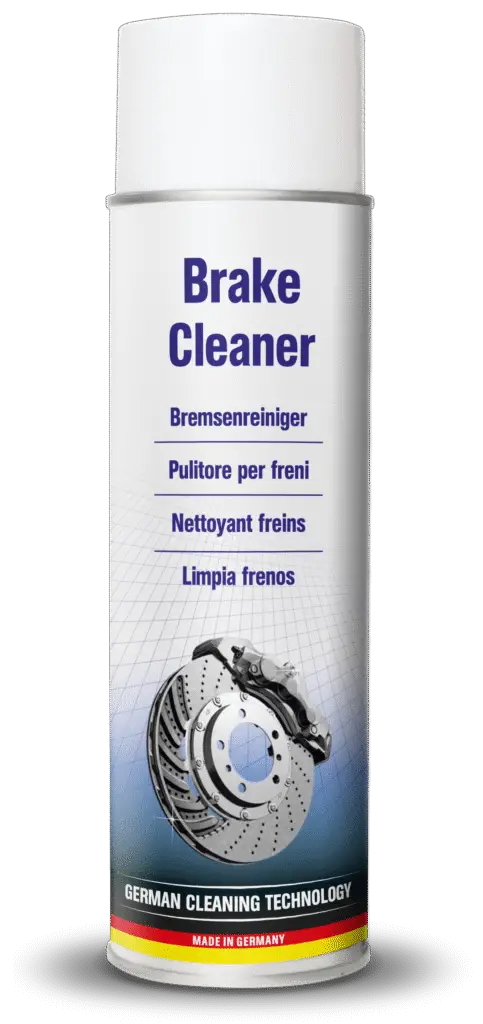Brake cleaner on skin can cause irritation and dryness, and prolonged exposure may lead to chemical burns. Always use gloves to prevent direct contact.
Brake cleaners are essential for automotive maintenance and repair, used to clean brake components such as pads, rotors, and calipers. However, brake cleaner, often considered a benign product for mechanical work, can pose significant risks when it comes into contact with the skin. Many brake cleaners contain potent chemicals that can lead to adverse skin reactions, ranging from irritation to chemical burns.
In this article, we will explore the dangers of brake cleaner on the skin, how to handle such exposure, preventive measures, and what to do in case of accidental skin contact.

Contents
What Is Brake Cleaner and Its Composition?
Brake cleaner is a solvent used to clean brake parts. It’s typically available in aerosol spray cans, but there are also liquid brake cleaner products. These solvents work by dissolving grease, oil, brake dust, and other contaminants from brake components, leaving behind a residue-free surface.
Chemical Ingredients of Brake Cleaners
Brake cleaners contain a variety of solvents that are effective in cleaning grease, oil, and other contaminants from brake parts. Knowledge about these chemical ingredients is important , as they can have different effects on the skin and health when exposed.
- Acetone: A powerful solvent often used in brake cleaners that helps dissolve grease, oils, and other contaminants. It can cause skin irritation and dryness when exposed.
- Toluene: A volatile organic compound (VOC) used in brake cleaners for its cleaning properties. It can be absorbed through the skin, leading to central nervous system effects and skin irritation.
- Methanol: A type of alcohol found in some brake cleaners that can be absorbed through the skin and cause a variety of toxic effects, including poisoning in high doses.
- Isopropyl Alcohol: Commonly found in non-chlorinated cleaners, it can cause drying and irritation of the skin but is less harmful than other chemicals like methanol.
Risks of Brake Cleaner on Skin
When brake cleaner comes into contact with the skin, the chemicals in the cleaner can cause immediate irritation, as well as long-term health effects. These risks are primarily due to the solvent-based chemicals in brake cleaners, which are designed to break down oils and greases. Unfortunately, these solvents also strip natural oils from the skin, leading to dryness, irritation, and other harmful effects.
Short-Term Effects of Brake Cleaner on Skin
When brake cleaner comes into contact with the skin, it can cause immediate reactions such as irritation and dryness. These short-term effects vary depending on the type of brake cleaner and the duration of exposure.
Skin Irritation
Brake cleaners contain strong solvents that can cause redness, itching, and a burning sensation on the skin. The irritation can range from mild to severe, depending on the concentration of chemicals in the cleaner.
Dryness and Cracking
Prolonged exposure to brake cleaner can lead to skin dehydration. This occurs because the solvents in the cleaner strip the skin of its natural oils. As a result, the skin becomes dry, cracked, and more susceptible to damage.
Chemical Burns
In some cases, if the brake cleaner is used improperly or exposed to the skin for an extended period, it can cause chemical burns. These burns might be mild or severe, leading to pain, swelling, and skin damage.
Allergic Reactions
Some individuals may develop an allergic reaction to brake cleaner, particularly after repeated exposure. Symptoms of allergic reactions include rashes, hives, and swelling.

Long-Term Effects of Brake Cleaner on Skin
Prolonged or repeated exposure to brake cleaner can lead to more serious skin conditions, such as chronic irritation, allergic reactions, and even systemic toxicity. Understanding these long-term effects is crucial to mitigating health risks associated with brake cleaner use.
Chronic Dermatitis
Repeated or prolonged exposure to brake cleaner can cause chronic skin conditions such as dermatitis. This condition can lead to persistent redness, inflammation, and cracking of the skin.
Skin Sensitization
Over time, continuous exposure to brake cleaner can cause sensitization. This means that even small amounts of exposure can lead to allergic reactions such as rashes and swelling.
Absorption Into the Bloodstream
Some of the chemicals in brake cleaner, such as acetone and toluene, can be absorbed through the skin and enter the bloodstream. This can have systemic effects on the liver, kidneys, and central nervous system, especially with prolonged exposure.
Cancer Risk
Brake cleaners, particularly those with chlorinated compounds, may contain carcinogenic substances. Although the risk from occasional skin exposure is minimal, long-term exposure could increase the likelihood of developing certain cancers, such as liver cancer.
How to Protect Skin from Brake Cleaner
Now that we understand the risks associated with brake cleaner on the skin, it is important to know how to protect yourself when handling this chemical.
1. Wear Protective Gloves
The most effective way to protect your skin is by wearing proper protective gear, specifically nitrile gloves. Nitrile gloves are resistant to many chemicals, including the solvents in brake cleaners, and will help prevent direct contact with the skin.
2. Use Brake Cleaner in Well-Ventilated Areas
Brake cleaner produces vapors that can irritate the skin and respiratory system. Always use brake cleaner in a well-ventilated area, such as outdoors or in a garage with proper ventilation. This will minimize exposure to both the skin and lungs.
3. Protective Clothing
If you’re working with brake cleaner for an extended period, consider wearing long sleeves, protective aprons, and goggles to minimize any skin or eye contact.
4. Proper Application Techniques
Always apply brake cleaner directly to the parts you intend to clean, not your hands. Use a cloth or brush to apply the cleaner to the components, avoiding direct spraying onto the skin.
What to Do if Brake Cleaner Comes Into Contact with Skin
Accidental exposure to brake cleaner is a common concern, especially in DIY and automotive repair work. Here’s what you should do if brake cleaner comes into contact with your skin:
1. Immediate Rinsing
As soon as you notice brake cleaner on your skin, rinse the affected area immediately with plenty of cool water. Use soap and water to wash the area thoroughly, as soap helps remove the cleaner’s residue from the skin.
2. Use Mild Soap
After rinsing, apply a mild soap to wash away any remaining chemicals. Avoid using harsh soaps or scrubbing the area, as this may further irritate the skin.
3. Moisturize
After cleaning the affected area, apply a moisturizing lotion or ointment to help replenish the natural oils in your skin. This will reduce dryness and prevent cracking.
4. Seek Medical Attention
If you experience a severe reaction, such as swelling, blisters, or pain, it’s crucial to seek medical attention immediately. In case of a chemical burn, you should see a doctor without delay.
Safer Alternatives to Brake Cleaners
If you are concerned about the potential health risks associated with brake cleaners, consider using safer alternatives. Many environmentally-friendly and skin-safe brake cleaners are available on the market.
1. Water-Based Cleaners
Water-based brake cleaners are less harsh than solvent-based cleaners and are much gentler on the skin. These products use water as a primary solvent to dissolve oils and contaminants without the use of strong chemicals.
2. Eco-Friendly Cleaners
There are several eco-friendly brake cleaner products that are specifically designed to be non-toxic and safe for skin contact. These products contain plant-based solvents or biodegradable ingredients, reducing the risk to both the user and the environment.
Frequently Asked Questions
Here are some FAQs about brake cleaner on skin –
1. What should I do if brake cleaner gets on my skin?
Immediately rinse the area with cool water and mild soap to remove any residue. If irritation persists, apply a moisturizer, and consult a doctor if necessary.
2. Can brake cleaner be absorbed through the skin?
Yes, brake cleaner can be absorbed through the skin, especially if exposed for an extended period or in large quantities. Some of its components, like toluene and acetone, can enter the bloodstream.
3. Is brake cleaner harmful to skin?
Yes, brake cleaner can be harmful to the skin, causing irritation, dryness, dermatitis, and even chemical burns in extreme cases. Chronic exposure may lead to long-term skin issues.
4. Can I use brake cleaner without gloves?
It is strongly recommended to always wear gloves when using brake cleaner to prevent skin contact. Nitrile gloves are the best option to protect against chemical exposure.
5. How can I prevent brake cleaner from affecting my skin?
To prevent skin contact, always wear protective gloves, use brake cleaner in well-ventilated areas, and apply the cleaner only to the parts being cleaned, not your hands.
Conclusion
Brake cleaner is an essential product for automotive maintenance, but its chemical composition can be hazardous when it comes into contact with your skin. By understanding the risks and using protective measures, you can minimize the potential for skin irritation and long-term health effects. In case of exposure, take immediate action by rinsing the skin thoroughly and seeking medical attention if needed. By opting for safer alternatives, such as water-based or eco-friendly cleaners, you can further reduce the health risks associated with brake cleaners. Always prioritize safety when handling such chemicals to ensure the well-being of yourself and those around you.